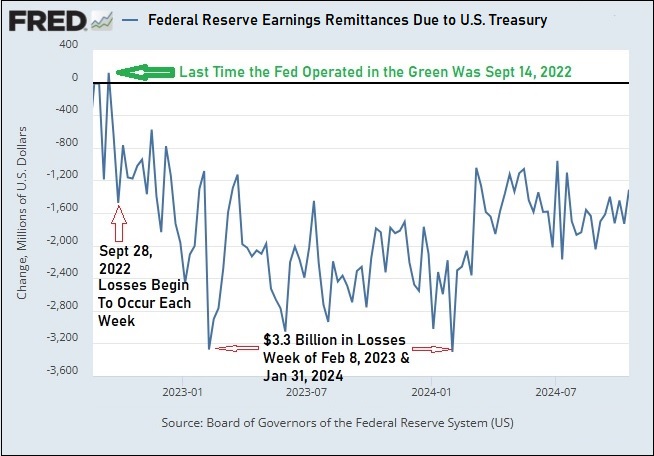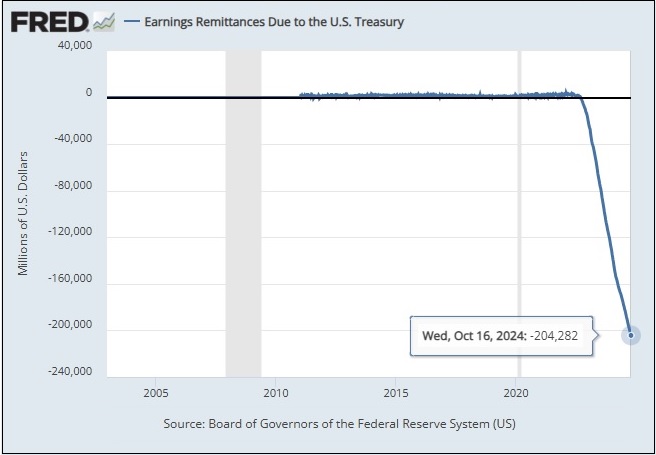SUBSCRIBE TO THIS NEWSLETTER TO RECEIVE TIMELY REPORT!
Jerome Powell’s Fed Notches an Historic Record of $204 Billion in Cumulative Operating Losses – Losing Over $1 Billion a Week for More than Two Years
Commentary Next to Arrows Has Been Added by Wall Street On Parade.
By Pam Martens and Russ Martens: October 21, 2024 ~
According to its own FRED data, the last time the central bank of the United States – the Federal Reserve – operated in the green was September 14, 2022, more than two years ago. Since then, it has been consistently losing over $1 billion a week with its cumulative operating losses now topping $204 billion as of the last reporting by the Fed on October 16, 2024.
Operating losses of this magnitude are unprecedented at the of Fed, which was created in 1913.
If a publicly-traded company had been bleeding operating losses of more than $1 billion a week for more than two years, there would very likely be a change of leadership at the top. But Fed Chair Jerome Powell is no ordinary mortal. He survived the worst trading scandal in the Fed’s history – even after his own trading conduct came into question.
These losses at the Fed are operating losses – where expenses exceed earnings. They are not to be confused with the unrealized losses on the Fed’s underwater debt securities that the Fed holds on its balance sheet, which it does not mark to market.
The Fed is experiencing these operating losses because the interest it is earning on its $6.6 trillion portfolio of debt securities that it acquired through its Quantitative Easing (QE) operations is less than the overly generous interest payments it is making to banks. These payments include the 4.90 percent interest the Fed is paying to the megabanks on Wall Street (and other Fed member banks) for the reserves they hold with the Fed. This morning, the yield on the benchmark 10-year U.S. Treasury note is just 4.13 percent. That yield hasn’t climbed above 4.50 percent for more than four months. So why is the Fed continuing to pay out the overly generous rate of 4.90 percent interest on reserves to the banks it supervises when it’s bleeding losses?
Is the Fed blatantly subsidizing bank profits while some of these same megabanks charge double digit interest rates to consumers on their credit cards? (See, for example: While JPMorgan Chase Was Getting Trillions of Dollars in Loans at Almost Zero Percent Interest from the Fed, It Was Charging Americans Hit by the Pandemic 17 Percent on their Credit Cards.)
The Fed is also paying out the overly generous rate of 4.80 percent on its reverse repo operations with giant mutual fund companies – many of which are owned by the megabanks on Wall Street. And, the Fed is paying a ridiculous 6 percent dividend to member shareholder banks with assets of $10 billion or less. Banks with assets above $10 billion receive the lesser of 6 percent or the yield on the 10-year Treasury note at the most recent auction prior to the dividend payment.
U.S. taxpayers have good reason to be alarmed by the Fed’s ongoing operating losses. That’s because when the Fed is operating in the green, the Fed, by law, turns over excess earnings to the U.S. Treasury – thus reducing the amount the U.S. government has to borrow by issuing Treasury debt securities. According to Fed data, between 2011 and 2021, the Fed’s excess earnings paid to the U.S. Treasury totaled more than $920 billion.
The loss of remittances from the Fed means that the U.S. government will go deeper into debt, putting a heavier tax burden on the U.S. taxpayer and raising the risk of another credit rating agency downgrade of U.S. sovereign debt.
Another problem at the Fed is that instead of being a beacon for pristine accounting practices, it is engaging in creative accounting according to experts. A January 31 paper by Paul H. Kupiec and Alex J. Pollock published by the American Enterprise Institute explains in stark detail why the Fed has negative capital under GAAP accounting. The researchers write:
“In 2011, the Fed unilaterally decided to adopt non-standard accounting practices that book operating losses as a ‘negative liability’ in its H.4.1 releases and as a ‘deferred asset’ in its audited financial statements [writing the following at the time:]
‘[I]n the unlikely scenario in which realized losses were sufficiently large enough to result in an overall net income loss for the Reserve Banks, the Federal Reserve would still meet its financial obligations to cover operating expenses. In that case, remittances to the Treasury would be suspended and a deferred asset would be recorded on the Federal Reserve’s balance sheet.’
“Unfortunately for the Fed, the ‘unlikely scenario’ has become reality. Regardless of the name used, the ‘deferred asset’ account acts to hide the basic immutable fact that operating losses have consumed the Fed’s capital.
“Under the Fed’s unique accounting policy, operating losses do not reduce the Federal Reserve’s reported total capital. The accumulated losses in the ‘deferred asset’ account allow the Fed to report the same capital account balance, no matter how large its accumulated losses. Even if it lost 100 times its capital, or $4.3 trillion, the Fed would still report that it has positive $43 billion in capital. Similar creative ‘regulatory accounting’ has not been utilized by financial institutions since the 1980s when it was used to prop up failing savings and loans.”
The researchers posted a line-item chart on page 8 of their report showing how the Fed’s accounting compares with GAAP accounting. As of December 27, 2023, the Fed’s accounting produces $42.85 billion in capital. Under GAAP accounting, the Fed’s capital stands at a negative $88.7 billion.
As anyone who is a regular reader of Wall Street On Parade will easily guess, the New York Fed has the most dramatic negative capital under GAAP accounting among the Fed’s 12 regional Fed banks. The researchers write:
“Restating each of the 12 individual FRBs [Federal Reserve Banks] December 27, 2023 capital accounts using GAAP, 8 have negative GAAP capital. Exhibit 2A shows the FRBs that have GAAP capital deficits larger than $1 billion. The Federal Reserve Bank of New York, with a GAAP capital nearly negative $70 billion, has the largest capital deficit followed by the Federal Reserve Bank of Richmond with negative GAAP capital approaching $12 billion and the Federal Reserve Bank of Chicago with $7.6 billion in negative GAAP capital.”
For a deeper understanding of the New York Fed’s symbiotic relationship with the megabanks on Wall Street, see These Are the Banks that Own the New York Fed and Its Money Button and If Wall Street’s Mega Banks Are Safe and Sound as the Fed Says, Why Do They Need a Half Trillion Dollar Bailout Facility at the New York Fed?



No comments:
Post a Comment
Note: Only a member of this blog may post a comment.